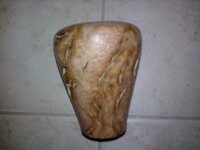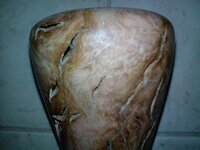angboy
Member
I turned this bottle stopper and it has lots of large voids in it. I want to put some sort of finish on it but am afraid that anything I try to apply will gunk up in the voids and look bad inside them, even if it looks good on the surface part. I was hoping to preserve them because I like the way they look, so I didn't want to fill them with anything. I guess I could leave it unfinished, but I don't know then what it'll look like after a couple of years of use. I had written "taz burl" on it, but that's about all I can tell you about the wood. Anyone have any ideas of what I should do?


